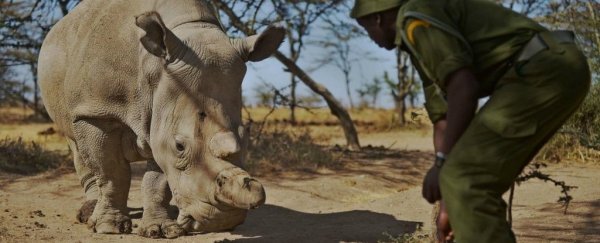A 28-year-old rhinoceros named Najin and her daughter, Fatu, are the only northern white rhinos on the planet. They live at Ol Pejeta Conservancy in Kenya under constant armed guard.
Both animals are infertile. In March, veterinarians euthanized Sudan, Najin's father and the last male rhino of their kind. Once Najin and Fatu die, so goes their subspecies.
But genes from the northern white rhinos might live on. There's a hopeful thread in a new study, published Wednesday in the journal Nature Communications:
For the first time, scientists have used in vitro fertilization to create viable rhino embryos.
An international team of zoologists, veterinarians and other researchers plucked unfertilized eggs from southern white rhinoceroses, a closely related subspecies with a population of about 20,000.
In a dish, the scientists used northern white rhinoceros sperm to fertilize the southern white rhinoceros eggs, producing hybrid embryos.
Two hybrid embryos have been frozen for future implantation, the researchers said. They predict, after developing the proper technique, it will be possible to transfer the embryos to female southern white rhinoceroses in the coming years.
A hybrid calf ensures some genetic continuity for the northern white rhino even after its extinction.
"This is a very ambitious, very brave last-ditch effort to save some of the genetics of a spectacular animal," said conservation biologist Stuart Pimm of Duke University, who studies extinctions and was not involved in this project.
Northern white rhinoceroses are not evolutionary failures. The rhinos failed, as biologist and study author Thomas B. Hildebrandt told reporters Tuesday, because their hides were not bulletproof.
They failed because rhino horns, gram for gram, are more valuable than gold - fetching high prices as status symbols or for their medicinal powders. (The horns, mostly made of a protein called keratin, are as medically useful as fingernail clippings.)
Hildebrandt, a professor at the Leibniz Institute for Zoo and Wildlife Research in Berlin, and his colleagues are part of a project that has been stockpiling northern white rhinoceros genetic material for decades.
Oliver Ryder, a conservation geneticist at the San Diego Zoo, collected skin samples from Sudan in 1986 as part of a rhino cell bank.
Scientists began to freeze northern white rhinoceros sperm in 2008, Hildebrandt said, storing 300 milliliters' worth, roughly the volume of a soda can.
But scooping up rhino skin and semen is relatively easy, at least compared with removing eggs from within a two-ton wild animal.
"This is quite the technological feat," said David E. Wildt, senior scientist at the Smithsonian Conservation Biology Institute, who was not involved with this research.
The study's authors used a 60-inch-long instrument (patent pending) to insert a needle through the anus of anesthetized southern white rhinos and into ovarian tissue. An ultrasound monitor provided the only guidance for the egg collectors.
The embryos are viable and "beautiful," Wildt said. He added: "This is the first step in a long journey to produce living offspring."
Veterinarians have successfully used in vitro fertilization in horses, cattle and other livestock, but never something as large as a white rhino.
Yet such techniques are the "only way" to save northern white rhino genes, said biologist Terri Roth, director of the Center for Conservation and Research of Endangered Wildlife at the Cincinnati Zoo.
These genes might benefit the southern white rhinos that move into their relatives' former habitats, or confer advantages to living rhinos during disease outbreaks.
The odds are against a complete revival of the northern white rhino, according to Roth, who oversaw the first successful breeding of a captive Sumatran rhino in 2001.
"Even if the moon and the stars all aligned," and a surrogate rhinoceros gave birth to a hybrid calf, "that still hasn't brought back the subspecies."
The San Diego Zoo's Ryder, along with Hildebrandt and other reproductive biologists, drew up a plan in Vienna in 2015 to rescue the subspecies.
It will be possible to bring back a complete northern white rhino, Ryder predicts, which would require an egg as well as sperm.
Hildebrandt and his colleagues plan to harvest eggs from Najin and Fatu, and the researchers are "extremely confident" that they would be successful. The highest risk is not failing to acquire eggs, Hildebrandt said, but to the adult rhinoceroses.
The animals must be anesthetized for two hours, "which is quite a risky situation".
One of Hildebrandt's co-authors is Kyushu University's Katsuhiko Hayashi, a pioneering reproductive biologist who helped turn mouse skin cells into eggs into living mice.
The team aims to replicate this success with rhinoceros stem cells. So far, they have generated 12 rhino stem cell lines, Hildebrandt said.
All of the scientists who spoke with The Washington Post agreed that biological techniques can complement boots-on-the-ground rhinoceros protection.
Funds allocated for laboratory research are not usually drawn from the same sources as funds earmarked for other conservation goals. "We should come at it with everything we've got," Roth said.
"It's a big, messy puzzle. There's not one piece that's going to be the answer," said Susie Ellis, executive director of the International Rhino Foundation.
"No species has ever been saved by the high-tech approach alone." The science is "very important," but it has to be paired with "working with local communities and politicians".
Pimm, as excited as he was about this result, offered a word of caution. We cannot afford to adopt a cavalier attitude toward extinction, as though animals were something to bring back at our leisure, he said.
"The main event has to be: We have to stop rhino poaching."
2018 © The Washington Post
This article was originally published by The Washington Post.
